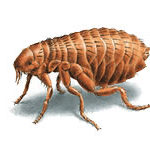Fleas depend on a blood meal from a host to survive, so most fleas are introduced into the home via pets or other mammal hosts. On some occasions, fleas may become an inside problem when the host they previously fed on is no longer around. Then fleas focus their feeding activity on other hosts that reside inside the home. An example of such a situation is when a mouse inside the home is trapped and removed, the fleas that previously fed on the mouse are then forced to feed on pets or people.
- Adults small, wingless, about 2.5 mm long.
- Their bodies are shiny and reddish brown in color.
- Covered with microscopic hair and are compressed to allow for easy movement through animal fur.
Adults are parasites that draw blood from a host. Larvae feed on organic debris, particularly the feces of adult fleas, which contain undigested blood. Fleas commonly prefer to feed on hairy animals such as dogs, cats, rabbits, squirrels, rats, mice and other domesticated or wild animals. Fleas do not have wings, although they are capable of jumping long distances.
Employing exclusion practices is important for many pest problems, but exclusion does not have a major, direct benefit for flea control. However, sealing cracks, gaps and holes to help keep rodents or other potential hosts from gaining access into the home is an important indirect way to keep fleas outside. The most effective ways to keep fleas from getting inside the home is to eliminate outdoor flea habitats and outdoor hosts, plus using area-wide flea control chemical products and veterinarian-approved flea control products on pets.
How To Identify and Manage a Flea Problem
Since fleas are relatively easy to see in their adult stage, most of the attention is directed at adult fleas. Adult fleas are usually easy to locate, especially if the homeowner and their pets return to the house after a long vacation or other absence during which the resident flea adults were not able to take a blood meal. Upon returning, the homeowners are often greeted by fleas jumping around and trying to land on them and their pets.
The flea eggs, larvae and pupae are another situation. Since these stages are much more secretive and much less active, they are found in out-of-the-way places like behind, under or in the furniture; in the pet’s bedding; inside cracks and grooves in the floors; and in the carpets. Flea eggs that were deposited by the female adult, fall off your pets as they move, allowing them to be disbursed throughout the environment where a pet spends time. Flea eggs represent about one-half of the entire flea population present in an average home. Larvae make up about 35 percent of the flea population.
If conditions are favorable, the larvae will spin cocoons in about 5-20 days after hatching from their eggs. The cocoons are the flea’s pupal stage and account for about 10 percent of the flea population. This cocoon stage is the last developmental stage before the adult flea emerges. If environmental conditions are not right for emergence, the cocoon can protect the developing flea adult for months or even longer. The adult flea does not emerge until a potential host is detected by vibration, rising levels of carbon dioxide and body heat associated with the host. A pet walking by, or people moving in the house alert the flea to emerge from its cocoon to feed. Once a flea has emerged from the cocoon, it will begin taking a blood meal on a host within 24-48 hours. Shortly after the first meal, adult fleas will mate and the female fleas begin laying eggs on her host within a few days. Female fleas are not able to lay eggs until they obtain a blood meal.
Do fleas carry disease?
Yes, fleas can transmit diseases when taking a blood meal from a host or via contaminated fecal pellets. Some flea-borne diseases include:
- Plague – transmitted by the Oriental rat flea
- Flea-borne typhus, also known as murine typhus – transmitted by the bacteria-infested feces of infected cat fleas when they enter the body at the time of the flea’s bite or from scratching the area of the bite.
- Bartonellosis –Oriental rat flea and cat flea bites may transmit cat scratch disease.
- Flea tapeworm – can be transmitted if children accidently eat an infected flea or contact infected feces.
- Tungiasis – a tropical area ailment that is caused by the chigoe flea (Tunga penetrans) when it burrows into the skin and takes a blood meal. As the adult female feeds, she grows larger due to the development of her eggs. The bite of the chigoe flea often results in secondary infections and itching.
Flea Control
Flea infestations require multifaceted treatment plans. Addressing only a pet’s infestation or individual flea bites will not prove effective for ridding your home of fleas. Effective flea control should encompass both chemical and physical methods and should be conducted on your pet as well as inside and outside of your home.
If you don not have pets and there is a flea infestation in your home:
- Inspecting for the presence of other animals that are the flea population’s source of food. This may include rodents either inside or outside the home or perhaps a raccoon or feral cat that is living in the crawl space.
For more information, questions or to speak with a company representative, Call 540-574-1110

